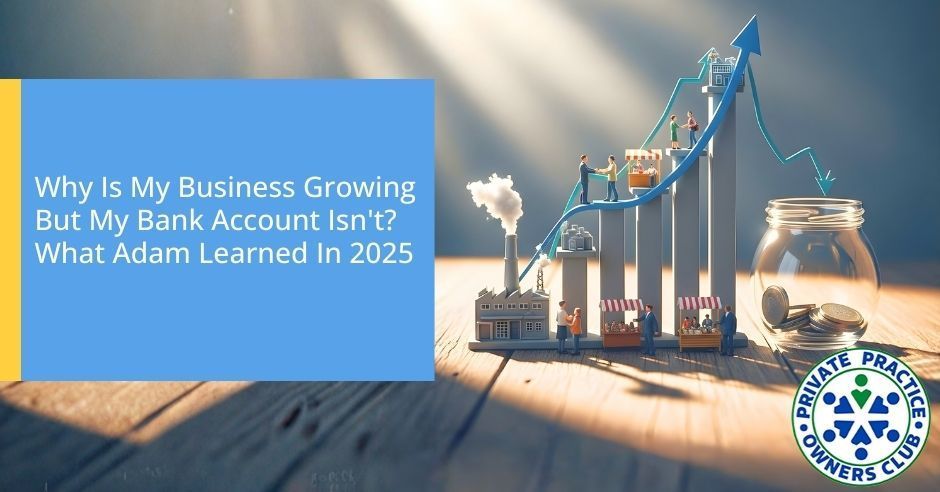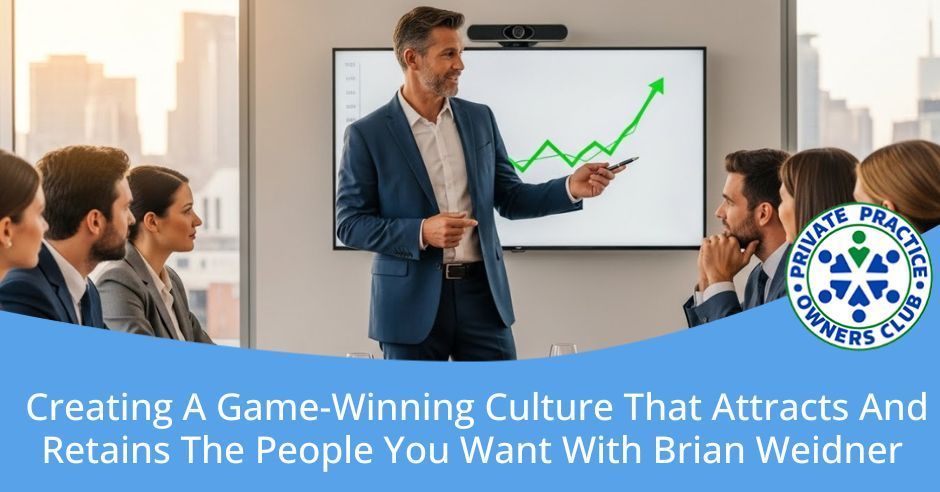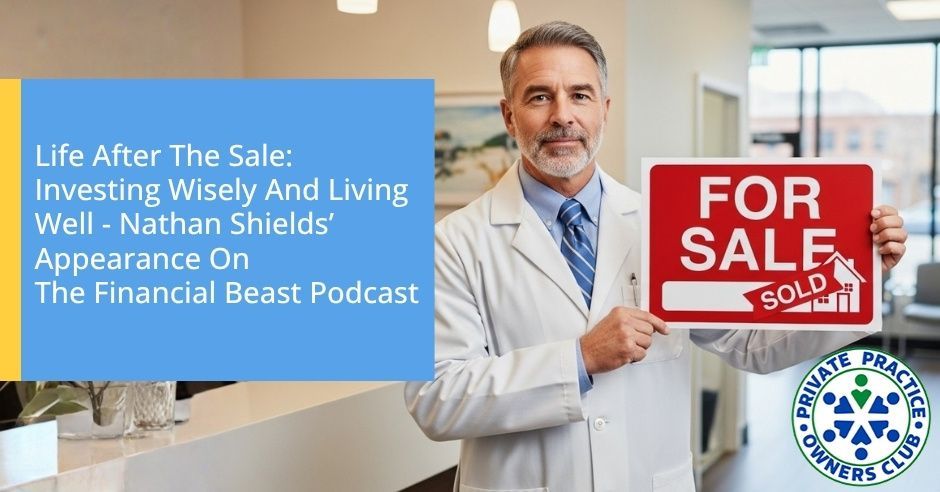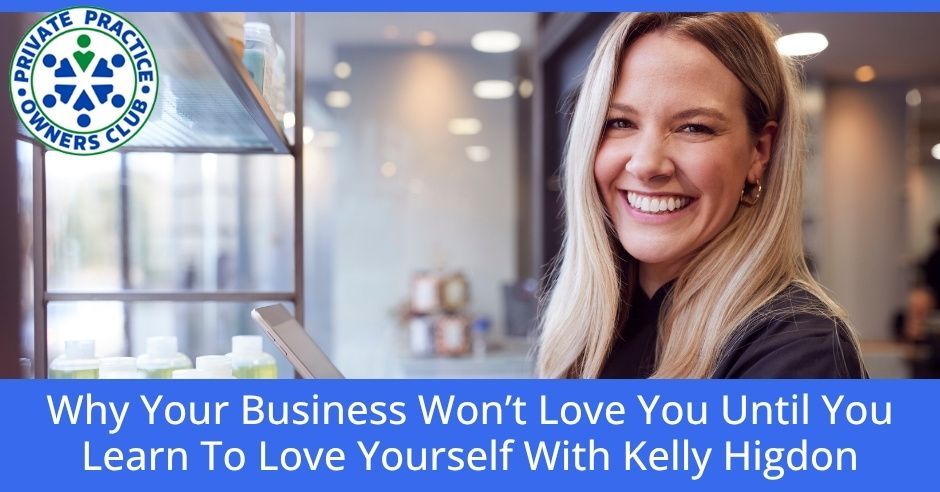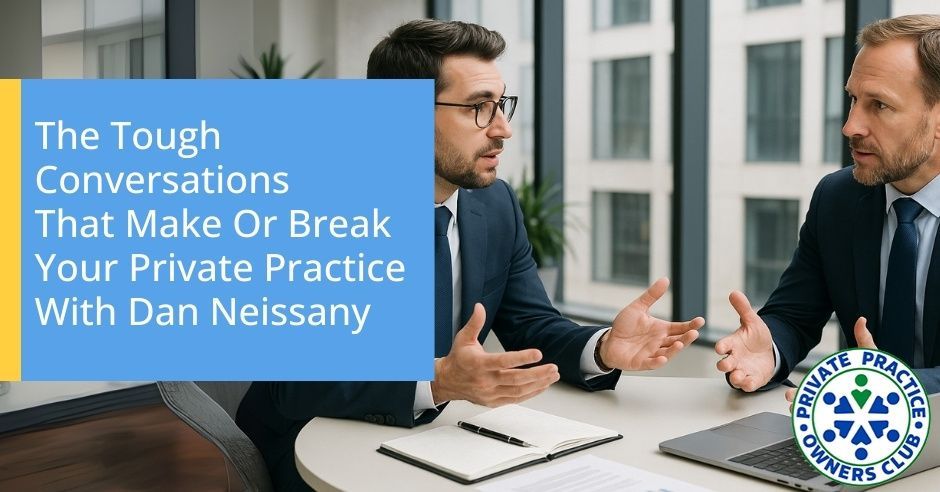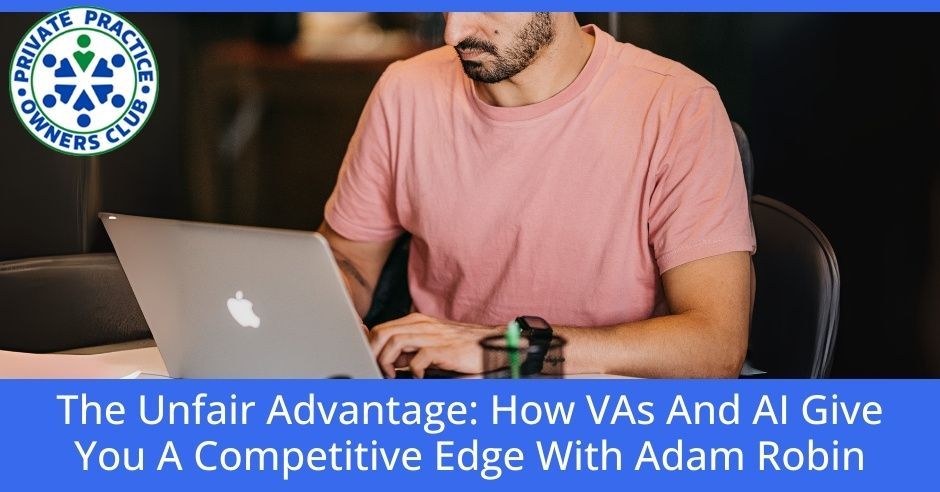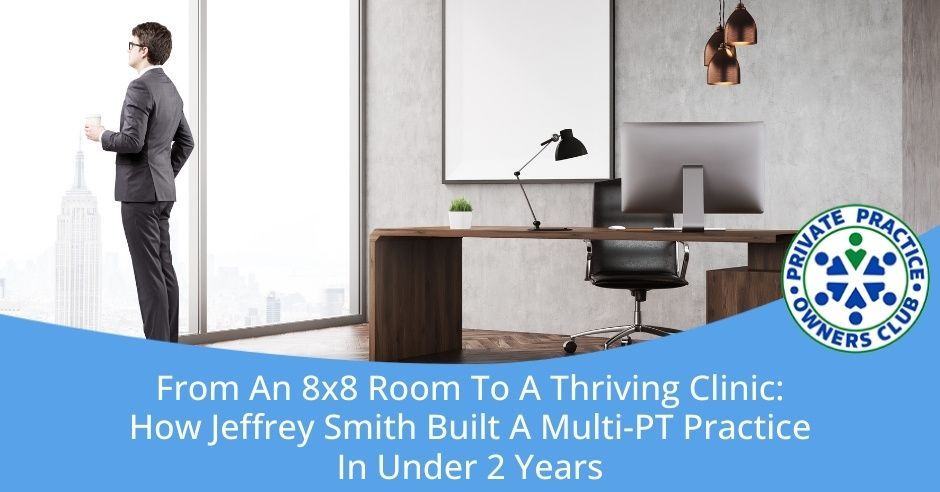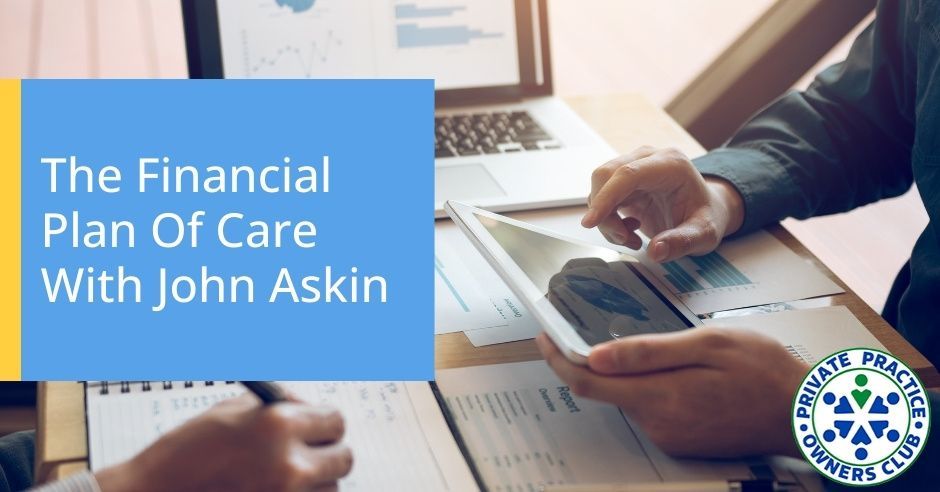Craig Brasington is the Director of Revenue Operations at Stride EMR with over 20 years of experience in outpatient therapy tech. A founding member of Clinicient, he’s passionate about building smarter EMR systems that simplify operations, improve patient care, and help clinicians focus on what truly matters.
Is Your EMR Holding You Back? The Truth About The Next Wave Of Healthcare Tech With Craig Brasington

If you’ve ever felt like your EMR slows you down instead of scaling you up, this episode is for you. In this episode of the Private Practice Owners Podcast, Adam Robin sits down with Craig Brasington, Director of Revenue Operations at Stride EMR, to unpack the evolution of healthcare tech — and what the next generation of EMRs really means for practice owners.
Craig shares his 20+ years of experience in outpatient therapy tech, from his early days as a founding member of Clinicient to his current work with Stride. Together, he and Adam explore how EMR systems have evolved from basic record-keeping tools to intelligent, AI-powered platforms built to streamline every part of your clinic — from scheduling to billing to patient engagement.
They dive into:
- The three generations of EMR technology (and why most practices are stuck in Gen 1 or Gen 2)
- How AI is transforming not just clinical documentation, but business efficiency
- What to consider before switching EMRs — and how to make the transition as seamless as possible
- Why “thinking small to grow big” is the mantra behind Stride’s success
If you’ve ever wondered whether your EMR is holding your practice back, this episode breaks down what the next wave of healthcare tech really looks like — and how to make sure your systems are built for the future, not the past.
🎙️ Learn why the right technology isn’t just about software — it’s about strategy, scalability, and sustainability.
👉 Learn more about Stride EMR at www.strideemr.ai
Want to talk about how we can help you with your PT business, or have a question you want to ask?
Book a call with Nathan — https://calendly.com/ptoclub/discoverycall
Love the show? Subscribe, rate, review, and share! https://ptoclub.com/
99.5% of successful owners interviewed on this podcast have leveraged a business coach to grow their business.
Private Practice Owners Club is the coach you need — ppoclub.com
---
Listen to the Podcast here
Is Your EMR Holding You Back? The Truth About The Next Wave Of Healthcare Tech With Craig Brasington
Special guest, new guy, Craig Brasington. He's the Director of Revenue Operations for Stride EMR. If you guys haven't heard of Stride, pretty cool company. I’ve met a few people on the team. Great group. I’ve also had a cool conversation with Craig and started to learn a little bit about the EMR. I was like, “I’ve got to get you guys on the show so we can share the story.” PT, OT, speech primarily is who they work with, specifically in the outpatient therapy space. We're excited to have Craig. Craig, how are you doing?
Doing great. Thanks for having me. Really excited to have an opportunity to chat with you.
Craig’s Career Background And Journey
Whenever we met, I was really just inspired by your story, like your history. You've worked with several different tech companies and it was really evident that you came with a lot of experience and perspective that I didn't fully realize. I thought it'd be really cool to just learn a little bit about you and maybe give you an opportunity to share that story and maybe add some value to the audience. Tell us a little bit about you. Let's start there.
I came into the space when technology was first getting in here. I’ve been in the outpatient technology space for many years, and was one of the original founding members of Clinicient, which was one of the bigger EMRs during the early days of browser-based tools that were out there in the world, WebPT, Raintree, Clinicient. I had the privilege to work with a series of really smart technologists that had stepped into the space, which is what was unique about Clinicient.
Versus it being a therapist owned product, it was a therapist-founded product with a technology group behind it. I got to learn from technologists how they handle and solve problems in a world that is driven by the provider. Jerry Henderson was our founding therapist and he was joined together with my father, actually Herb Brasington, who had built one of the first electronic submission tools for claims back in the ‘90s and early 2000s to create Clinicient.
And during that process, they met me and offered me a job. I came over and started with them. It was an interesting run. I ran pretty much everything in the company, support, implementations, training, onboarding. I worked into the sales end of things. I wrote specifications for the actual product itself and learned more about physical therapy than I thought I might ever know in a very short period of time.
Great origin story, the company took off. We were playing out there in the world with WebPT, who was the dominant player in the space and got to the point where we were a nuisance enough to where they just bought us. Back in 2021, they acquired Clinicient and I rolled over and worked with WebPT for a while and got to see a much larger organization in our space and how they delivered technology and their more therapist focused view of the world, which was also refreshing.
I went out on my own, opened up my own consulting shopper. I worked with a bunch of therapy groups to help them look at technology, what works best for us? What is my environment need? How can I leverage the years of evolution of these technologies to really take a an organization forward? I did that for a while and then I met the guys at Stride who I'd been talking to a few years and they showed me their new product. I was floored that this thing that was at the time about two and a half years old was as evolved as it was. It was a 10-year-old product and a 3-year-old company, hence why I joined the team here.
Why Craig Joined Stride EMR
I'd love to hear more. What was it that you saw in the Stride EMR? Could you explain more about that? What was it that really stood out that really blew you away?
That's what it did. It really blew me away. Taking it back to Clinicient, one of our first visions that we had at Clinicient was to create this single system product. Back in the day, everything was just integrated together using some rudimentary integration capabilities and it tended to fail regularly and/or just not speak well to one another because they weren't written in completely different codes.
What I saw in what we saw then was you needed to build it all in one place. It had to be the hub for all technologies and it had to do 90% of everything that you need to do. In certain instances, you're going to run into technologies that simply make sense to plug in. You can't Frankenstein a product. You need to build it yourself for a number of reasons.
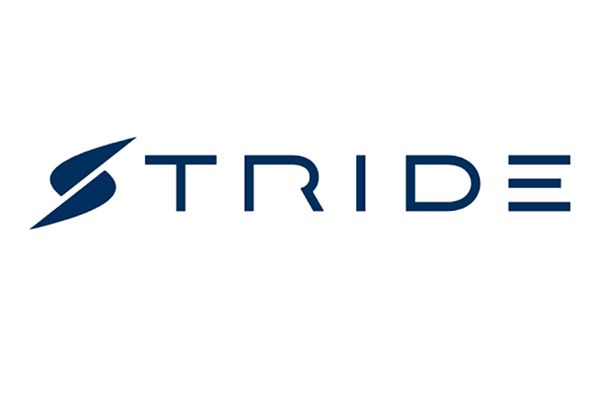
That vision, which we tried to reach at Clinicient a little early in the technology run in our space to actually come to fruition, they had the same vision, had built what I had thought of well before Stride was a thing. The fact that they had seen this the same way and they'd gone about building it themselves and then taking the most modern technologies and using those to build out that product much more quickly, much more cost-effectively, and then deliver a premium product to the market in a short timeframe.
They're very agile, they build things quickly, they deliver on changes that you can't typically do in a large company just because of all the red tape that typically exists in the development process. Just that agile nature and the fact that they had built a thing that was the vision that we had at Clinicient long ago were the main reasons that I fell in love with Stride and came on board.
Where's the company based out of?
We're based out of Brooklyn, New York. The two founders are Ryan Limor, who is out of technology and product in the area, and Dan Blank, who is our CTO. He is out of the finance world. Even more complicated than HIPAA when it comes to building out products. That's where they came out of and they built a team mainly based in Brooklyn. They have a few of us, like myself, who live out in different far-reaching parts of the world, like Portland, Oregon.
What I'd like to get clear on is what does this mean for the practice owner. Okay. Really cool. Technology, we believe you. Sounds good. Sounds cool. What does that mean for the practice owner? Why should they consider Stride versus maybe some other EMR?
There are different use cases for each different practice. As we know, rarely do you run into a practice that's exactly the same as the other and they have their different ways as how they like to do business. This goes back to my consulting days. Picking a technology very much has to do with you mapping your need to the product that's available. You understanding where you sit and the level of reimbursement that you have and what kind of product you can afford.
Things like that are really important to consider before you step even into the realm of looking at products. Once you've determined where you sit and what problems you have and the value you're looking for, then you can start looking at the different products to see how they fit into your world and it needs to fit in your world.
What does that mea,n though? Let's break that down. You said mapping your need to the technology. Can you give an example of what you mean by that? What would be an ideal scenario for an owner?
A good example of mapping a need, I have a very high turnover in my front office. I am constantly bringing people in and training them. I sometimes only have one person working and they're a one-armed paper hanger as it is. I need technology to step in and allow me to offer up times for people to schedule on their own or patients to register and check in and complete their intake without me having to do any of that work.
That's a very common problem you see in clinics and finding a tool that solves that problem. That's your core problem. You need to find a tool that does that. That bleeds into other things when you think about that problem. It's also a data cleanliness problem. Now I need a tool that's going to help me get that correct so that down the line, my therapist has the right information. My biller, most importantly, is getting the right information so that this stuff doesn't have to be worked over and over again. Eating further into that profit.
Typically, a pain or a problem like that is much deeper and more widespread than the problem itself seems to be. Understanding where you sit and then evaluating technologies that look at that and help with those types of areas is really the key in that. When you are in the decision-making process, you take the time you think about what it is.
These folks on the other end of the phone tend to be experts in their area. This is a great opportunity to gather information and learn from them as well. An organization you're looking to partner with should always be that consultant, if you will, back to my old job being more of a consultant than a salesperson. They're not just talking about price or a feature set, they're talking about you and what you need to know, and then what moves you in this process. That will solve the problems you have. As an example, front desk being a limited resource would be a great example of a problem that you might have.
That's really interesting because it's easy to think that all practice owners have the same problems, but they don't. As an owner, sometimes you feel like you're on an island and if you don't understand that every single state and every single part of the country has different markets and different problems, different challenges, then you might feel like you're the only one. Everyone has the exact same type of problem, therefore, any EMR can work for you, but really, it's about finding the right EMR for you and your specific challenges in your area. That's really cool. I’ve never thought about it like that.
Use technology to offload your workflow as much as possible so you can work on more important things.
It's interesting if you think about the founders of the companies. My PT was a very therapist-based company, so they focused on the therapist workflow, some of the clinical. No desire to go into billing until later in their existence. Their strength still lives in that clinical experience. The technologists that I worked for looked at the overarching problem and built a tool that could touch all of those areas and work into each area to add a wind-down here at my front desk that affected the end of it. If I'm a billing-based product, now I’ve got a tool that thinks about the end of the process very well, very detailed or detail-oriented to solve that problem. Finding out what the best mix is for you is really important to understand solve the problems you're specifically at.
Where does Stride fit on that continuum? What problems do they solve? What are you guys good at?
When I left WebPT, I looked at all of the competitors out in the world and I went through the interview process and I knew most of them already anyway from just years of conferences and other meetings that you sit and run into people. The reason I like Stride is because it took the approach that everything in the organization had equal value to driving a good outcome in the end.
My billers being efficient had to be a thing. My front desk, being able to optimize what they do and be able to handle volume and be able to offload a lot of the work to technology so that they can keep up and decrease air was another huge component because that also fed the billing. Everything has to revolve around the therapist because, of course, that's the time you have to sell, which is where your revenue really lives.
I need to make sure that each one of those groups within the organization can manage their work, do it in a very effective, efficient fashion, and then use the technology to overlay their workflows to offload as much as is possible. This allows me to attack a lot of different areas. All systems will allow you to attack a lot of areas. Some will have more focus than others. I prefer the overarching look of a single system model.
Understanding Generational Changes In Technology
We did talk at one point about this evolution of technology that you've noticed along your journey. I believe you mentioned something around something like Generation 1 technology and then Generation 2 and now it sounds like we're somewhere around Generation 3 and I’ve never heard that before. I thought that was really cool. I'd love if you could share that story again with the audience so that way they can have some context around that.
Understanding where technology is in the moment that you're looking at technology is incredibly important. I don't want to buy a product that is good now, but in two years, it's already gone past its prime. Understanding where the technology sits and how they're using modern technology to benefit not just themselves, but you, the practice owner, the therapist, the biller, the front desk person.
I’ll break it down like we did before, all the different generations themselves. I like to categorize them in the technology change. A generational change in technology is what a hallmark to a Gen 1, a Gen 2, a Gen 3 of anything is. Our Gen 1 technologies were the Clinicients of the world, the WebPTs of the world, the Raintrees even, even earlier on in that process that were represented in the shift from a server-based model to a SaaS based model, software as a service.
That can be delivered via the web and/or the cloud. Cloud hadn't come around yet, but the web, you're able to access your data, it's stored in the cloud or on the web in a secure fashion so that you can offload cost and you can have a much more robust technology that you're running within your clinic and operating in. That's where the Raintrees first came out of and then the Clinicient and WebPT, the more browser-based tools evolved from.
That browser now allowed us to deliver information out to you on these smaller devices at a lower cost point and then allow us to push out updates out to the end users in a very cost-effective, efficient way and for developers to build tools and then roll them out to people in a very effective way. The problem with the technology at the time was not necessarily that the technology couldn't get the job done, but the focus of an EMR at the time was solely to offload the record storing and management of data, so it was a tool of record, if you will.
Those tools came along and they evolved and they started to handle all the things you did in a clinic, but it wasn't in a very effective or efficient way. They couldn't integrate with other partners terribly well because of where they sat. Even though you were on the internet, you still lived in a data center somewhere on the planet. You had to build these interactions across the internet to interact with somebody else. Apis didn't exist at the time. It was not very cost-effective. It was a very cumbersome way of communicating information.
We all lived in that for a long time. We built some pretty decent tools within the technology and then comes a generational shift. That shift was the concept of now having the cloud available for me so I can scale at a significantly higher rate, my capability to manage a level of customer, or I can scale my product. I can spin up new virtual servers to handle different loads automatically through that process so my performance has gotten better, my reliability got better, and then the actual technologies have evolved so I could write more sophisticated and more capable tools for everybody.
You started seeing things like Prompt come out, which was head and shoulders above the existing products. I know that because I was one of the existing products. I got to meet the guys at Prompt very early on. They were very great guys that I met at I believe it was the Orlando State Conference back in maybe 2016, something like that. Really cool. They were taking it from a different angle. There's a group that was looking at it from now we have this thing that we can build quicker, more cost-effectively. We can scale, we can build modern technology with a lot of cool new things in it and focus on one of the big problems that existed in healthcare at the time and still does the day.
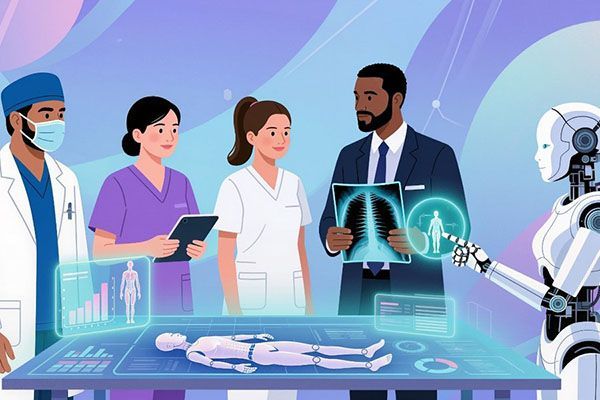
However, it was getting the administration, the front desk, some of those folks you get a lot of churn from and providing them tools to help them make their job a lot easier, a lot more accurate so that all the downline effect from that could be felt by your therapist, by your biller, all those different things. They did a phenomenal job doing it. They came in at a very advantageous time. That was a very big shift in technology that had occurred a couple of years just before they launched.
Now that technology has blown up and the Prompt guys have done a great job in evolving that and moving it forward. They're now starting to take some of the hallmarks of a Gen 3 product and apply that to some Gen 2 technology stacks, which is very helpful as well. I’ll explain the difference here in a second.
You have a few new products coming out and you start to see a broader range of more capability in the space. Your Gen 3, the big change here a couple of years ago, and everyone's heard it because we talk about things like this all the time, is of course the advent of AI and machine learning. Now that has changed the landscape of how everything is done. Not just looking at it from a how does it benefit me, the end user. Let’s say I'm a therapist and I want to use ambient listening and all those other things in my documentation. Super helpful, incredibly powerful. How do I build the product itself so that I can bring a product to market that is significantly more cost-effective for me to build and deliver a premium product in a way that's done very differently than before?
Now the AI isn't just something you're bolting on to solve a problem or a couple of problems. You have a an LLM that's built into the system so that you can surface it whenever you need to within the user experience. You can use it as you're developing and decrease the number of developers you need to get a job done. It’s 6 developers developing what 25 could get done. That's a cost savings to the developing companies.
The EMRs are being able to build these things faster at a lower cost point and deliver products to you guys that evolve much more seamlessly over time, have less likelihood of becoming outdated. They can evolve themselves and continue forward. Using the AI in a very thoughtful way is a key thing to that as well. It's not just blanket UI usage, it's augmenting the individual user, the human that's dealing with it.
My developer becomes five times more effective. My front desk staff has a tool that offloads 60%, 70% of their work. That is just the menial task because just me not clicking buttons. The therapist has every way they want to interact with their documentation as well. Whether it be ambient listening or just AI scribing, it has a summarization tool. You're using adaptive AI maybe in your intake forms and it allows them to bubble that up.
Cost effectiveness is really the big key here. It's not just building it cheaper. It's now delivering AI capability cheaper because you own the LLM, you built the AI yourself and you're evolving it as you go along. Now you can bubble that up whenever you want to at just the transactional cost of what AI costs. That is a transactional thing.
Every time I use it, it costs a little bit of money here and here. If you're not buying and bolting on, that means you're not paying the other company's R&D cost. You're not paying the profit margin. You're not paying their markup on everything that occurs or you're buying the company and then you're incurring millions of dollars in costs that I'm now delivering this for.
Similar problem when you're buying or revolving with third-party partners in some of these areas. Gen 3 is the utilization of AI and utilizing it much like you do within the clinic, but even in the development of that product and how you manage everything you do in the day. Basically, living what you preach for the clinics that are utilizing your product. It’s three different generations.
Interesting. The one thing that comes to mind, the question that I have, and I'm thinking about this from a business perspective, what happens whenever you are an EMR that has built their entire company off of a Gen 1 or a Gen 2 type of technology? You explained it a little bit about the Gen 2, you have to bolt the AI on, and maybe it's a little inefficient.
Gen 1 and 2. We did the same thing back in the day when we started running to the end of our technology's capability. That's the answer at the time.
The question is, in your view, obviously there's a price limitation. It's going to be more expensive to build, therefore it's going to be more expensive for the customer. What are some of the other limitations that come with that type of setup? I don't know of a better word. If a company like that wanted to graduate to let's say a Gen 3, what would that even look like? Is that even possible? How does all that work?
That's a fantastic question because in technology, that is always the question. How to stay relevant is you must innovate. Keep innovating within the technology stack I have and/or I now see these guys that have built some newer things on different technology stacks that I can plug in and move the needle within my product, within my user group. That was always the hallmark to it.
The advent of AI and machine learning has changed the landscape of how everything is done.
Once you get to that point, it's called Frankensteining of a product. Plugging things in different arm, different leg, this kind of stuff. You've seen Frankenstein move. It's a great analogy because, of course, it's not exactly how a human works, but it's close. The interfaces that existed in Gen 1 really limited it because they were two-way integrations, but they were built between Point A and Point B and that is it. It really limited. You built it for every single thing you did.
Gen 2 has the benefit of API, which is allowing you to open up endpoints for credentialed individuals to be able to come back, come in and grab certain pieces of data in a much more cost effective, easier way. That was huge evolution of that, allowing you to now do that. It still has the limitation of I have a code base here that is not the same as here potentially. I have two tools that aren't built the same way talking to one another and you built time together as best you can. AI agents have come in. Now you can use Gen 3 technologies to streamline that a little better too. I can have an agent go through that API and do work within that system.
Now I’ve just tied three different technologies together. That's a costly solution. They can evolve to a degree, but the core of their product is where they need to continuously move forward. That's the tough part because the pieces around it are already more modern. It's the piece in the middle, the hub for everything that is needing to be able to evolve forward. If it's not built in the right way, the architecture isn't done correctly, it makes it very hard to evolve it forward.
Gen 3 technologies, again, are sitting on a different thing and they're using things that can think about how I need to evolve, what else do I need to do? API is just a set, a matter of fact second thought that you have about how you interact in the world. They can, but typically what happens is it's done outside of the product and they build that next version of it with a path of integration coming from the previous.
We did this at Insight back in the day, at Clinicient back in the day when we rolled out our InsightGO product, which was a Gen 2 product. We were a Gen 1 company moving into the Gen 2 world and we built a bi-directional interface with the core product so that you could adopt that new thing in your own time in a way that made sense. That's our theory.
The problem was we now left you in two worlds in that scenario. We didn't force the move, which at one point it is good to push people that direction, but we left it hanging out there. Honestly, I believe Clinicient is still that way now where you can work both ways. Brilliantly done, unfortunately, caused their own problem of not getting people to adopt a new product.
A couple of ways it can be handled, but typically, you're building it outside here and you're building this new amazing tool and then you're going to have a data migration question. How do I take what they have now and get it into the product of tomorrow in a seamless way that doesn't cause a lot of strife and pain for the customer base? Some change is always that way, though, and that's fine. People understand that. You have to do a great job architecting that path. That's where the real hard work comes once you've built that new Gen 3 product or whatever it is.
I'm going to let you guys figure that out. I don't know, it's way above my head.
There's definitely a lot to it for sure. Innovation is key. That's really it. Build it in a different way. The newer products are being built modularly. I can plug and play pieces to the core product as I want to evolve it. Let’s say I have my schedule out there for three years and I want to put in a newer scheduler that has a lot of new capabilities. I can actually build that out here and then just plug it into the core so that now, all of my users, everyone that's on that product don't have to go anywhere. It's just, all of a sudden, a new piece of the product that has more capability and has evolved itself.
Now, if I do that modulate over time, I can continuously innovate in each area that I’ve built. In the old days, you build the scheduler, it was really good. People loved it. It didn't get thought about until someone started hating it because something great came out 3, 4 years later. Now you can look at your product and periodically evolve the product so that you're never making a generational shift. You're making a short-term shift to a slightly different technology. It's just a different approach to development and evolution.
AI Assistant Waitlist And Patient Relationship Management Tool
I know you mentioned AI, but specifically, what are your favorite features or maybe a better question is, what are your current customers favorite features, specific features inside Stride?
AI is used a lot. Automation is another thing. You're building automations within a system to simplify or offload work or get things done. The most popular feature that we have right now would have to be the AI assisted wait list. When you need to find someone to fill a spot when canceled on Tuesday and it's Monday and you need to find someone, the AI sees an opening and it says, “I know the patients that you have listed in your priority, the organization and what other priorities you might want to set for them.” I'm going to send out invites these guys via text, “It looks like a time that you were looking for is open at this time. Go ahead and click.” It gets it as soon as someone grabs it and tells the other folks, “Sorry you missed it this time. Next time, we got you at the top of the list.”
They know they're there, they're moving on. It's keeping that schedule full as things progress or they just see open time that's out on Wednesday. It says, “Maybe no one noticed this. Let me go out and grab some folks and introduce that to them.” It’s one of the newer features that came out here at the beginning of 2025 that people are really liking.
Never lose sight of the why of your organization. Always remember the reason why you started everything.
A couple of other things that they love is the online scheduling component to it and marketing pieces so I can brand myself out in the world. My PRM, our patient relationship management, tool allows you to build campaigns and workflows that automate your typical communications. It can send a text to your patient just following up with them at the end of their visit or something like that. “Just checking in, see another visit went.”
It creates that human connection between you and the patient and you don't have to do every step of it. Some automations that are in that workflow that are really popular and then that reaches out into the world of a patient never even knowing who you are. I can get myself out there and put out campaigns and put out things in on the web or have a landing page to an event I'm hosting and then be able to drive them to a patient capture experience.
What I mean by capture is it captures their information and allows them to freely see your availability and then pick a time to come see. Take down the barrier between care and the patient and let them look whenever they want. It's midnight, it's 2:00 in the morning, whatever it happens to be, they can find what they need and not move on to the next guy. Those have been our most popular features that we've rolled out in 2025.
Transitioning To EMR As Cost-Effective As Possible
I’ve got one more question for you. The one issue or caution that I have with practice owners is the transition from EMR to EMR. It's a big one. It's heavy. It doesn't always have to be heavy, but to be fair, I’ve never done it. I'm only speaking from what I'm seeing. How do we get somebody to transition to your EMR from whatever they are, Gen 1, Gen 2, whatever they are, and do it in a way that's like as painless and as cost effective as possible. What's the solution there?
Change management. It is the thing that has been wondered about forever and has never been solved and probably they never will be. You can make it better and better over time. This goes back to some of the earliest things I did at Clinicient actually, which was ushering people from into the product from other places. The limitations of what you could do, it started with a spreadsheet that you can add load data onto. We can pull in some basic patient information, maybe a payer list or something like that.
Our industry specifically has not adopted a true data integration model where it's looking at that database grabbing what it is and pulling it over because it is incredibly cost ineffective. It's fraught with error and there's a lot of things you can't do. What the more modern products are doing is opening up what they can pull in and whether it be from a report that they can be generated right out of that system where you have a list of five reports to generate with everything you need to know about it.
That can be just ingested into the receiving system, or it's a data file that you get from your former EMR, which is a requirement of all EMR to provides you your data. It all has to do with the timing of it to make it better or worse, but they send our file broken down by patient with their numbers and all the other things tied to it, their attachments, things like that. Newer systems have the ability to grab all of that and then bring it into the system.
It's not your AR, it's not things like that because working existing claims makes it very difficult to go in and have to recreate a claim that could be submitted from a different source to a payer and things like that. There typically is a burn-down period of the old AR and the existing until it gets to a patient balance and you just balance forward. Being able to get all as much data as you can over into the system in a meaningful way and then attaching it to it.
When you start in the system, your therapist, for example, can go back and say, “There's that last note exactly as I wrote it. I understand it as I write it, my first note within this system.” There are a number of steps that we do at Stride to make sure that that transition is seamless, but also done in a way that doesn't threaten cash flow. We'll get to that one in a second as well as in adoption. These are the two biggest things that implementations and onboarding typically struggle with if these things aren't done correctly.
First, protect the money. That's the answer. I’ve got to make sure that happens. A good implementation is 6 weeks, maybe 8 weeks for a standardized organization. It'll get more custom with larger, but the first thing they help you focus on, and these guys will help you focus on it, is getting the clearinghouse stuff set up correctly and transitioned into their clearinghouse instance or if they're moving from clearinghouse to clearinghouse, helping with enrollments, helping with setup, making sure everything is done, and then testing of that.
All of this is happening while you're still in the process of learning the new tool and getting set up on that end the end user experience. Simultaneously, you're training and evolving where you are now. That is now set up, we've tested it weeks in advance. Now you're getting to the point where you're training your staff.
Training staff's important and key because you want a high level of adoption. These tools have been built in a certain way because they know what they're doing. Getting the proper training and the time for that to sink in with the providers and the front desk and the biller is incredibly important because you give them the time to do that, they learn it, they understand the methodology behind it.
When they go live that day of go live, which is the big hair on fire day, for most what people think anyway, they get in there and they're worried, they're absolutely nervous, but because of the steps that had been done up to that point, and then the practice period right before, they get in there and they are 80% proficient already. A couple of days later, you're like 90% and by the end of the first week, you're humming at the same pace you were before.
If you introduce it properly and train them correctly, you see a high level of adoption. Typically, providers and administrative staff, billers love this because they're moving from a tool that isn't nearly as capable as the new one. Introducing it to them early and the benefits, not just the features that they're about to use, is a key thing in their transition.
All of that being done and guided by a proper onboarding and implementation team is key. I’ve known many of folks at Clinicient, WebPT, Prompt and other companies that do this as well and there are some fine individuals out there to help clinics get through that very difficult process and as easy a way as possible.
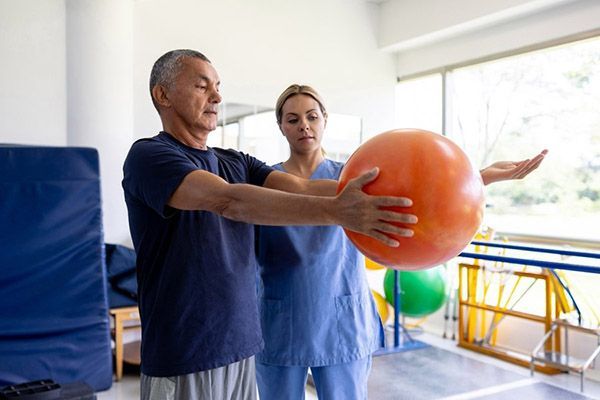
It requires a lot of bandwidth from the owner, at least.
A good bit from the owner, a good bit from the onboarding team for sure, but trying to limit the amount of effort from the end user in the clinics and the practices is key so they can focus on what they need to know and get that down and then we can move them forward.
Thinking Small To Grow Big
Is there anything else that you feel like is in really important for them to know? Did we leave anything else out?
I'd say the thing that I love the most about working at Stride is it reminds me of WebPT when they were first founded. It reminds me of Clinicient when it was first founded. Prompt as well, where there are a bunch of people there that are thinking about and doing things for the right reason. That is why you want to be with an organization. Organizations change over time, all of them do, but you try to fight it.
One of the mantras they had here that I absolutely loved was think small, grow big. They're always thinking about what it was like now. What do they care about now? Even though you may be growing a little bit bigger in a technology company as you do, but always thinking about why do we do this to begin with, who did we focus on, and making sure that group of people are still the focus for everything you do within the organization. I'd never heard it said that way. It really resonated with me during the interview process as I went through it.
Get In Touch With Craig And Stride EMR
I'm sure there's going to be lots of people who are interested in learning a little more about what you guys are doing. For people who reach out to me, what do you want me to send them? How do they get in touch with you or your team? What's the best way to connect?
Probably the easiest way is to send them straight to our website, which is StrideEMR.ai. That way, you can learn a lot about what we do. Click through. We have some ROI calculators to help you understand your scenario in certain areas so you can get in and get a good feel for it before you even have to talk to somebody else. You can go through and go ahead and click and it'll take you in and you'll be able to pick a time that works for you. Someone like myself will be reaching out to usher you through the process and help you figure out what might work best for you.
Are you going to go to PPS?
Yes, we'll be at PPS. Love to see everyone there. We're going to be hosting a big Happy Hour Tin Roof on Thursday night, 6:30. Come by the booth, you register. Amazing band. It's an eight-piece band that's playing all the top hits. Should be a lot of fun.
Craig, thanks so much. I’ll be at PPS so we'll catch up then.
Absolutely. Look forward to seeing you. Thanks.




